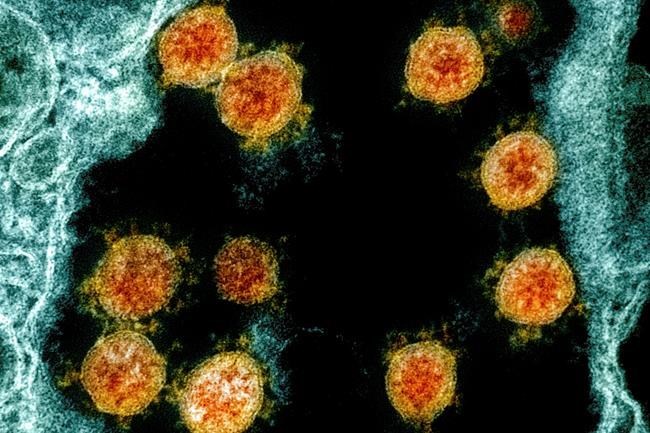
This electron microscope image made available and color-enhanced by the National Institute of Allergy and Infectious Diseases Integrated Research Facility in Fort Detrick, Md., shows Novel Coronavirus SARS-CoV-2 virus particles, orange, isolated from a patient. THE CANADIAN PRESS/AP-NIAID/National Institutes of Health via AP
June 17, 2020 - 1:00 AM
Thousands of scientists around the world are working on problems raised by the COVID-19 pandemic. Here is a summary of some recent research from primarily peer-reviewed academic journals and scientific agencies:
---
Close that toilet lid before you flush, says the American Institute of Physics. Researchers in the institute's journal Physics of Fluids modelled the amount of droplets that can be created by pushing that lever. They say the turbulence caused by flushing can propel droplets to nearly a metre above the bowl, where they might be inhaled or settle on surfaces. The droplets are so small they float in the air for over a minute. A toilet with two inlet ports for water generates an even greater velocity of upward flowing aerosol particles. Recent research has suggested the novel coronavirus can survive in the human digestive tract and show up in feces.
---
A University of California study has found that nearly two-thirds of U.S. organizations that provide outdoor environmental and science education say COVID-19 might force them to permanently close their doors. The authors estimate about four million children had missed out on such outdoor programming by the end of May. About 60 per cent of those were students of colour or from low-income families. They say those students are most likely to lose environmental education within their local school districts.
---
The journal Science is reporting on the start of clinical trials for a COVID-19 treatment that uses a cocktail of human antibodies. The authors say using a combination of at least two antibodies to treat the novel coronavirus is more effective and guards against the chance that the infection could develop resistance to a single antibody. They screened thousands of human antibodies to develop pairs that worked well together. The trick, they say, was to find pairs that didn't compete with each other to attach themselves to the part of the virus that binds to healthy cells.
---
The Proceedings of the National Academy of Science has examined the effectiveness of face masks in slowing the spread of COVID-19 in New York and Italy. Comparing infection trends before and after mandatory face mask rules were implemented, the authors estimate the measure prevented more than 78,000 infections in Italy between April 6 and May 9, and more than 66,000 infections in New York City between April 17 and May 9. They say the figures point to the significant role of airborne transmission in spreading the novel coronavirus.
---
Several new papers in the journal Science describe newly discovered human antibodies that target the novel coronavirus. The antibodies were discovered in COVID-19 patients. Three patients provided 403 antibodies between them. Eight of those also showed the ability to protect from viruses related to the one that causes COVID-19, suggesting they might have application against future coronavirus outbreaks as well as the current one. The antibodies could help design drugs to treat COVID-19 and future related illnesses.
---
The journal Science is reporting that having a young population less susceptible to COVID-19 doesn't necessarily help low-income countries that have weak health care and high levels of intergenerational contact. It says that in such locations, public health measures that slow but do not interrupt transmission will still lead to COVID-19 epidemics rapidly overwhelming hospitals and other facilities. The authors say in those countries, efforts to mitigate the virus that causes COVID-19 will need to be maintained or triggered more frequently.
---
This report by The Canadian Press was first published June 17, 2020
News from © The Canadian Press, 2020